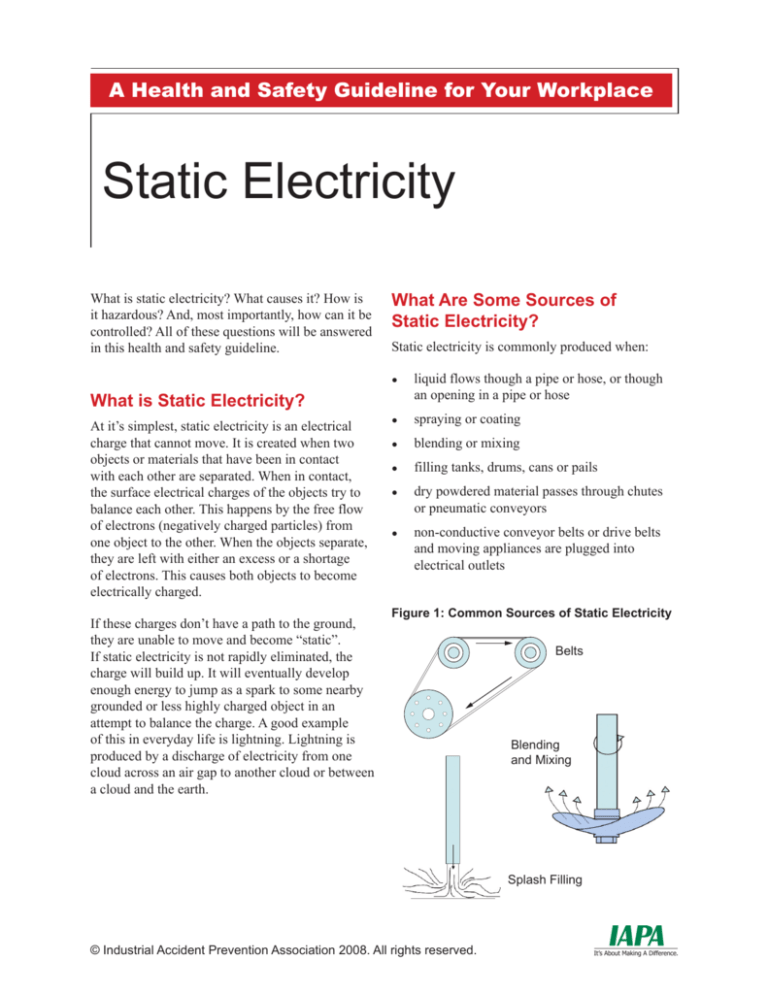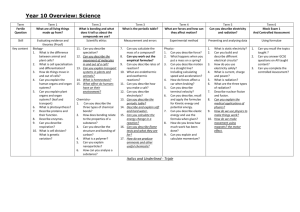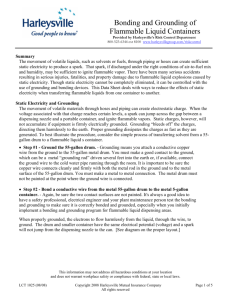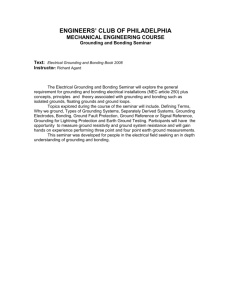
A Health and Safety Guideline for Your Workplace
Static Electricity
What is static electricity? What causes it? How is
it hazardous? And, most importantly, how can it be
controlled? All of these questions will be answered
in this health and safety guideline.
What Are Some Sources of
Static Electricity?
Static electricity is commonly produced when:
●●
liquid flows though a pipe or hose, or though
an opening in a pipe or hose
●●
spraying or coating
●●
blending or mixing
●●
filling tanks, drums, cans or pails
●●
dry powdered material passes through chutes
or pneumatic conveyors
●●
non-conductive conveyor belts or drive belts
and moving appliances are plugged into
electrical outlets
What is Static Electricity?
At it’s simplest, static electricity is an electrical
charge that cannot move. It is created when two
objects or materials that have been in contact
with each other are separated. When in contact,
the surface electrical charges of the objects try to
balance each other. This happens by the free flow
of electrons (negatively charged particles) from
one object to the other. When the objects separate,
they are left with either an excess or a shortage
of electrons. This causes both objects to become
electrically charged.
If these charges don’t have a path to the ground,
they are unable to move and become “static”.
If static electricity is not rapidly eliminated, the
charge will build up. It will eventually develop
enough energy to jump as a spark to some nearby
grounded or less highly charged object in an
attempt to balance the charge. A good example
of this in everyday life is lightning. Lightning is
produced by a discharge of electricity from one
cloud across an air gap to another cloud or between
a cloud and the earth.
Figure 1: Common Sources of Static Electricity
Belts
Blending
and Mixing
Splash Filling
© Industrial Accident Prevention Association 2008. All rights reserved.
People can also accumulate static charges
generated by clothing or footwear. This is most
likely to happen in dry atmospheres, such as heated
buildings in winter, or when walking across carpets
and then touching a metal frame or door.
What Are the Hazards
of Static Electricity?
The main hazard of static electricity is the creation
of sparks in an explosive or flammable atmosphere.
These sparks can set off an explosion or fire. The
danger is greatest when flammable liquids are
being poured or transferred.
Bonding and grounding
Bonding and grounding are common controls for
static electricity. Bonding is connecting two or
more conductive objects with a conductor, such
as a copper wire, that equalizes the potential
charge between them (see Figure 2). Bonding is
also connecting various parts of equipment and
containers that are electrically separated by, for
example, gaskets or caulking compounds. Note that
bonding does not eliminate the static charge.
Figure 2: Bonding Two Conductive Objects
Bond Wire
+++
For static electricity to be a hazard, four conditions
must be met:
1. There must be a means for a static charge to
develop.
2. Enough energy must build up to cause ignition.
3. There must be a discharge of this energy (a
spark).
4. The spark must occur in an ignitable vapour or
dust mixture.
+++
When bonded together, both
objects share the same charge
Grounding is connecting one or more conductive
objects directly to the earth using ground rods,
cold water copper pipes, or building steel. Unlike
bonding, grounding drains the static charges away
as quickly as they are produced.
Static grounds must not be made to:
How Can Static Electricity
Be Controlled?
●●
electrical conduit systems
●●
plastic pipes
Most static electricity control measures provide
ways for the static charges to dissipate harmlessly
before sparks occur.
●●
gas or steam pipes
●●
dry pipe sprinkler systems
●●
lightning rods
●●
metal storage racks
●●
building support beams
Some ways to prevent static charges from
accumulating on materials are:
●●
bonding and grounding
●●
humidification
●●
static collectors
●●
additives
A designated ground source is preferred.
Static Electricity
© Industrial Accident Prevention Association 2008. All rights reserved.
2
Connectors for bonding and grounding, such as
copper wire and clamps, must provide a good
conductive path. To ensure this:
●●
remove all dirt, paint, rust, or corrosion from
areas where connections are to be made
●●
use connectors that are strong enough for the
job
●●
use flexible connectors where there is vibration
or continuous movement
●●
connect metal to metal
●●
protect ground clamps, and fittings and
connectors from physical damage
Figure 3 shows some typical examples of
connectors. For more information, consult your
safety supplier.
Figure 3: Some Examples of Connectors
When dispensing flammable liquids, both bonding
and grounding are required. Ensure that the
receiving container is bonded to the dispensing
container before pouring the liquid, and that the
dispensing container is grounded (see Figures 4
and 5).
Figure 4: Bonding and Grounding
while Dispensing
Screw clamp
Solvent Drum
Wire ground conductor
Bus fastened
to rack
Flexible
wire
bonding
Terminal
lug
Spring
clamp
Ground conductor
Safety
can
Ground
Bonding or grounding will not eliminate the
surface charge on vessels holding flammable
liquids. To prevent static in these cases, make sure
that the nozzle is touching the bottom of the vessel
so that the liquid discharges horizontally. Also,
lower the rate of flow. These two measures will
prevent the free fall and turbulence that generate
static.
Where liquids are dispensed from their original
shipping containers using portable pumps or by
gravity through self-closing valves, the pumps
or valves must be designed in conformance
with good engineering practice. Products tested
and listed by recognized agencies (for example,
Canadian Standards Association, Factory Mutual,
Underwriters Laboratories of Canada) are
considered to meet this requirement.
Non-metallic containers, such as polyethylene
plastic or glass, cannot be grounded. To minimize
the build up of static charges near the surface
of liquids being poured, limit the filling rate to
velocities less than 1 m/s by using a grounded lance
or nozzle extension to the bottom of the container
to limit free fall, or use antistatic additives. All
metal parts on plastic containers must be bonded
to the fill pipe on the container being emptied.
However, as far as possible, avoid using plastic
containers for holding flammable liquids and
plastic sheets for wrapping.
Static Electricity
© Industrial Accident Prevention Association 2008. All rights reserved.
3
Figure 5: Bonding and Grounding while Top Loading a Tank
Product
flow
No sparking potential between
downspout (fill pipe) and truck
Alternative locations for
bonding wire fastened to pipe
Tank truck with
no charge on
outside surface
Alternative location for bond
(only if inherently connected
with the loading piping)
Ground
Humidification
Additives
A relative humidity of 60% to 70% at 210°C
(700°F) may prevent paper or layers of cloth
and fibers from sticking together. A high relative
humidity, however, is no guarantee against the
accumulation of static electricity. Therefore, don’t
rely solely on humidification as a control measure
in areas where there are flammable liquids, gases,
or dusts.
Another control is the use of anti-static additives
(as in fuels). The additive increases the
conductivity or lowers the resistance of the liquid.
It also reduces the time it takes for the static charge
to leak through the wall of the container and to the
ground.
Controlling static electricity on people
Static collectors
Devices that collect static electricity can be used
on moving belts, plastic film, and similar nonconductive materials. Some examples of static
collectors include: needle pointed copper combs;
spring copper brushes; and metallic tinsel bars.
A static collector works by its closeness to the
source that generates the static electricity. If a
discharge occurs, it is captured by the highly
conductive collector; this prevents long hot sparks.
To be effective, collectors must be properly
grounded.
Controls to prevent or reduce static from building
up on people include:
●●
conductive flooring
●●
conductive clothing and footwear (to allow the
charge to be conducted away; these items must
be free of dirt and other contaminants)
●●
cotton or linen clothing instead of wool, silk, or
synthetic materials
Static Electricity
© Industrial Accident Prevention Association 2008. All rights reserved.
4
Checklist
This is a sample inspection checklist for bonding and grounding systems. Modify it to suit your needs.
Department:
Yes
No
Recommended Action
Bonding cables:
●● in good condition
●●
good contact points
Bonding clamps:
●● in good condition
●●
good metal connection
Grounding conductors:
●● in good condition
●●
lead to earth
Static electricity ground:
●● direct to good earth
The following are free of static grounds:
●● electrical conduit systems
●●
plastic pipes
●●
gas or steam pipes
●●
dry pipe sprinkler systems
●●
lightning rods
Continuity checked
Conductivity measured
Safety cans:
●● bonded and grounded
Initials of person doing inspection: ________________ Date of inspection: ________________
Static Electricity
© Industrial Accident Prevention Association 2008. All rights reserved.
5
Legislation
Ontario Regualation 213/07 (2007). Fire Code.
Part 4, Subsection 4.1.8 – Handling of Flammable
and Combustable Liquids.
Ontario Regulation 851, Regualtion for Industrial
Establishments. Section 22, Subssection 4.
Source: http://www.e-laws.gov.on.ca/
For More Information
American Petroleum Institute, “Precautions Against
Electrostatic Ignition During Loading of Tank
Motor Vehicles,” March 1986.
Ontario Ministry of Community, Safety and
Correctional Services, Office of the Fire Marshal,
“Commentary on Part 4 of the Ontario Fire Code,”
January 2001.
National Fire Protection Association, NFPA 77,
“Recommended Practice on Static Electricity,”
2007.
© INDUSTRIAL ACCIDENT PREVENTION
ASSOCIATION, 2006, 2008.
All rights reserved. As part of IAPA’s mission to inform and
educate, IAPA permits users to reproduce this material for their
own internal training and educational purposes only. For any
other purpose, including use in conjunction with fee for service
or other commercial activities, no part of this material may be
used, reproduced, stored in a retrieval system, or transmitted in
any form or by any means, electronic, mechanical, photocopy,
recorded, or otherwise, without the express prior written
permission of the Industrial Accident Prevention Association.
The information contained in this material is provided
voluntarily as a public service. No warranty, guarantee
or representation is made by IAPA as to the correctness,
suitability, fitness, or sufficiency of any information contained
in this material. Use of this material means that the user agrees
that IAPA and its employees will not have and are released
from any liability whatsoever, however caused or arising, in
connection therewith. Users also acknowledge that it cannot
be assumed that all acceptable safety measures are contained
in this material or that additional measures may not be required
in the conditions or circumstances that are applicable to the
user or his/her organization, and that the user will personally
make his/her own assessment of the information contained in
this material.
While IAPA does not undertake to provide a revision service
or guarantee accuracy, we shall be pleased to respond to your
individual requests for information.
Canadian Electical Code 19th edition, 2002.
Section 10, Grounding and Bonding.
Revised: May 2008
Resources
Industrial Accident Prevention Association
Static Electricity is one in a series of guidelines
designed to help make your workplace safer and
healthier. Other guidelines on this website include:
●●
Fire Extinguishers
●●
Fire Protection
●●
Flammable Liquids Storage
●●
Bonding and Grounding Illustrations (a
collection of illustrations showing 19 typical
assemblies and 4 typical confirmation
assemblies, is also a useful resource)
Static Electricity
Toll-free: 1-800-406-IAPA (4272)
Website: www.iapa.ca










